

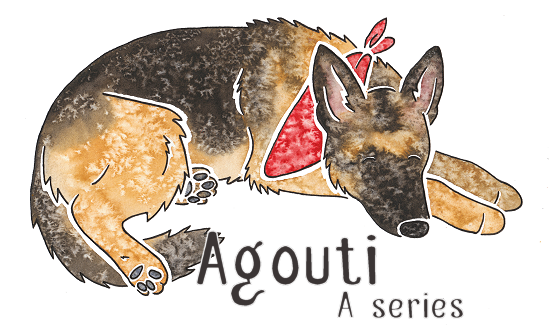

Already know what you're looking for? Quick Links | |
The Agouti Series
The agouti series is currently known to consist of four alleles:
Broadly speaking, the agouti series controls which cells produce eumelanin (black pigment, or liver/isabella/blue when modified) and, in the case of the agouti gene itself,
when.
This pattern of the spread of eumelanin (black/liver/isabella/blue) hairs is followed by all of the genes in the A series (with the exception of recessive black). There seems to be something inherent in the dog agouti series that causes this pattern, although it's not currently clear what this is.
It's important to note that the genes on the A series can only be expressed if the dog has one of the following genotypes on the K locus: kyky, kykbr,
or kbrkbr. kykbr and kbrkbr will add brindle on top of any phaeomelanin areas on the dog (see the Brindle page for more information and examples). If the dog has just one KB allele then it will be solid black (or liver/blue/isabella) due to the dominant black gene. A dominant black dog may be genetically a sable, tan-point or agouti, but
it will not be able to display it, except as "ghost" tan or seal (see K locus page).
All of the phaeomelanin areas in the coat of any of the agouti series patterns can be affected by the Intensity locus. Intensity causes the phaeomelanin to range in shade from deep Irish Setter red to pale cream or ivory.
It's generally accepted that many breeds display incomplete dominance on the A locus, with the appearance of the dog being affected by its more recessive allele as well as the more dominant one. This is particularly noticeable in breeds such as the GSD, which is one of the only breeds to have all four agouti alleles.
Sable
Sable (Ay) is the top dominant in the agouti series, so a dog only needs one sable allele to express it.
There are at least three types of pattern that can be caused by this gene, but it's not certain what causes each one to appear. It's probable
that sable is simply affected by (as yet unidentified) modifiers, and in some cases more shading may also be displayed when the sable is a carrier of the tan point (at) allele.
The three common patterns are: clear sable, tipped sable and shaded sable. The Shetland Sheepdog above is an example of a shaded sable.
Note that in many breeds, the term "sable" means a dog with shading and not a clear sable. This can cause confusion when describing dogs with the Ay allele as sables. When I talk of "sable" on this website I'm referring to the Ay allele, not to what's regarded as the sable phenotype (i.e. what's described as a sable) in different breeds.
Clear sables are completely red dogs with just a few eumelanin (black/liver/isabella/blue) hairs. They can be almost impossible to distinguish from
recessive red dogs (see the E series page) unless they have a eumelanin mask (Em), which never appears on recessive reds (because
they're unable to produce any eumelanin). If there is any black, liver, blue or isabella in the coat at all, the dog must be a sable rather than a recessive red. This includes the whiskers, which can be a useful indicator of recessive red vs sable in an otherwise clear dog.
Tipped sables are red dogs with eumelanin hairs (black/liver/isabella/blue), usually on the back, head, ears and tail. It seems that most tipped sables also have masks (Em), so
it's possible there is a link between the two genes (although not all masked sables have tipping).
Shaded sables overlap with tipped sables and are red dogs with brown and black hairs covering the top of the head, ears and back, in a distinctive pattern similar to the pattern
seen on dogs with creeping tan (see below). The shading can be very light (just some scattered dark hairs forming a rough pattern), or very
dark and distinct. A distinctive feature is the "widow's peak" on the forehead, where the brown or black forms a point.
As with all A locus patterns, shaded sable can also be blue, liver or isabella depending on whether eumelanin modifiers are present.
The dogs above would all be described as sable. However, the Borzoi's coat pattern almost certainly has a different genetic basis to the others. Sable in Borzoi, grizzle in Salukis, and domino in Afghan hounds are very similar patterns to shaded sables, including having a widow's peak, but they have been shown to be caused by a different gene found only in those breeds. Shaded sables in English cocker spaniels are also caused by a another, breed-specific E locus gene. See the E series page for more
information on grizzle/domino. One important thing to note is that true grizzle/domino dogs are unable to display masks, whereas sables are.
Shaded sable occurs mostly in longhaired breeds, but it can cause some interesting and unusual effects on shorthaired dogs, including the dorsal stripe seen here.
Solid brindle dogs, like the three shown here, are genetically sable. Without the brindle allele, they would look just like the clear and tipped sables above. Any shading on the sable can be difficult to see when the coat is brindled, but it will still be there.
Agouti / Wolf Grey
Agouti is one of the oldest and most widespread mammal colour genes. It can be found on rodents, deer, wild rabbits, and it's also the
main colour phase of the wolf. The main reason it's so common is the camouflage it provides.
Agouti is typified by strands of fur that are banded. This means that as the fur is growing, first the cells produce one type of
pigment (usually eumelanin, so black/liver/blue/isabella pigment) and then they switch to another type (usually phaeomelanin, so red). The gene that tells the cells to keep changing the pigment they produce is
generally classified as aw. The "w" stands for "wild type". The wild type is the standard/common colour that an animal occurs in, which in the case of wolves (and therefore dogs) is agouti.
Now the agouti gene in rabbits and deer produces banded hairs all over the coat, but for some reason the agouti gene in dogs is a little
different. It restricts the banded hairs to certain parts of the coat, which are, roughly, the upper parts (back, head, top of legs etc). It's a gene
inherited from the wolf, and can be seen on many breeds which are considered to be close to wolves (e.g. Czech Wolfdogs, Saarloos Wolfhonds), as well
as some Northern spitz-type breeds (Keeshond, Elkhound).
In its normal form, agouti can be very similar to shaded sable. The main difference is the banded hairs, but if you can't get close
enough to see those (and sometimes sables can show some similar banding due to tipping), the pattern is also slightly different. Agouti tends to follow a similar pattern to traditional tan points (with a nose "bar" instead of a widow's peak) rather than creeping tan or shaded sable (see below), although
it does vary a little. Another distinctive feature is the "spectacles" of tan that often appear around the eyes.
When combined with phaeomelanin dilution (see the I locus page), agouti becomes much more distinctive, as the red hairs become cream or greyish. The result is a wolf grey dog, like the Keeshond, Vallhund or Elkhound. The Elkhound below
has partial dilution of phaeomelanin, which leaves cream points, and the Husky has almost full dilution of phaeomelanin, leaving off-white points. The three dogs below are probable agoutis, although as stated above it can be difficult to tell these apart from shaded sables in photos.
It's also worth noting that so-called "sable" German Shepherd Dogs are in fact agouti.
Agouti dogs may lighten significantly as they age, as this dog shows.
Tan Points
The tan point gene (sometimes known as "traditional tan points") is almost the bottom recessive in the agouti series (the only one below it is recessive black, which is very rare).
This means that, generally, a dog must have two copies of the tan point gene in order to express tan points, so their A locus genotype must be
atat.
The range of markings on a tan pointed dog are very restricted. Red (tan) appears as pips above the eyes, on the sides of the muzzle extending to the cheeks,
as pips on the cheeks, on the front of the neck just below the head, as two triangular patches on the front of the chest, on the lower legs and feet (and inside of the legs), and as a patch underneath
the tail (and sometimes along the bottom edge of the tail too). The main colour is solid black (or any other eumelanin colour - liver, isabella or blue - depending on the
other genes involved).
Sometimes black marks are present on the toes. This is called "pencilling".
These photos show just a few of the modifiers than can affect tan-pointed dogs. The Dobermann is homozygous for liver (bb), turning its black into brown.
The Saluki cross in the middle has very light tan points, most likely modified by the Intensity gene that determines how rich the red (phaeomelanin) pigment is. The Cardigan Welsh Corgi has the brindle allele (kbr). Brindle only affects phaeomelanin, so this dog's points are brindle but its body remains solid black. This Corgi also has white
in the irish spotting pattern.
Tan-pointed dogs with the dilution (dd) gene. The first two dogs are blues, and third is an isabella (liver gene combined with dilution).
The first dog shows some tan shading on its side. This generally occurs when the undercoat shows through on a double-coated dog, and can also be a sign of CDA (colour dilution alopecia) in blue or isabella dogs.
The German shepherd dog in the middle has very dark/muddied points, and the blue extends further down the legs than on many tan-pointed dogs. In this breed this is sometimes associated with carrying a recessive black (a) allele, due to a slight incomplete dominance of tan points over recessive black. Both of these Australian Shepherds have tan points and white in the irish spotting pattern. The dog on the left would be described as a "black tricolour" (or "black tri"). The dog on the right is genetically a black tri but also has the merle gene (Mm), which has diluted random sections of the black to grey.
This English Shepherd looks like a black-and-tan, however the red areas on the neck and shoulders give away that it is actually a very heavily-shaded sable, probably carrying tan points. This is an interesting example showing how the patterns overlap.
Saddle Pattern and Creeping Tan
Previously, it was thought that the saddle and creeping tan patterns may be caused by their own alleles on the A locus. However, a gene, known as RALY, has recently been discovered that is a modifier of the tan point gene. Saddle tan or creeping tan dogs have one or two copies of this gene mutation, and it is now testable.
The saddle/creeping tan modifier causes the black (or other eumelanin colour) on a black-and-tan dog to "retreat" to the dog's back, leaving the rest of the coat red. A dog with the creeping tan pattern has
slightly more red/tan than a normal black-and-tan - usually spreading to the area around the eyes and extending further up the legs - see below for an example of this compared to a normal black-and-tan. The saddle pattern is the next step up from this,
where the red extends over the whole head, the front of the chest/neck and the top of the legs, leaving black only on the back, tail and the back of the neck.
Sometimes the saddle can have interspersed red hairs. This occurs in some terrier breeds and is known as grizzle (this is not the same as the E-locus grizzle/domino gene, even though the terms are the same!). A terrier with interspersed hairs can also sometimes be described as "smutty".
The RALY gene does not appear to work on sable (Ay), but can affect both tan-pointed or agouti dogs (the clearest examples of agouti saddles occur in German shepherds, where they are known as "patterned sables" - "sable" being the breed-specific term for agouti) Saddled and creeping tan dogs are usually born black-and-tan. The black recedes as the dog grows.
This Pembroke Welsh Corgi shows black receding from 6 weeks to 3 years.
Are these dogs with minimal saddles, or are they sables? The line between the two can be very blurred and it is not always possible to distinguish between them, even on dogs with more eumelanin pigment. For example, look at the dogs in the shaded sable section above - are these actually shaded sables or do they have
creeping tan or saddles? However, in general, the eumelanin on a creeping tan dog will be much more solid than on a sable.
The only way we can be certain that a dog has the saddle or creeping tan modifier is if the dog was born with the classic tan point pattern.
Recessive Black
Recessive black is a rare, recently discovered gene which is the bottom recessive in the agouti series. It occurs mostly in herding breeds such as the German Shepherd, and looks identical to dominant black. Although it is rare in dogs, similar genes are fairly widespread in other mammal species. See the page on black (K locus) for more information on recessive black.
Aw in Border Collies
There are few breeds where A locus alleles don't seem to quite match up with our understanding. Border collies lack agouti (aw) patterning, and only have sable and tan points (although their sable can be very extensive and look a lot like agouti). However, many border collies test as aw despite having the tan point pattern. It seems that this breed has a currently unknown and untestable A locus allele. Watch this space for any further updates on this allele.
Interactions With Other Locii
We have mostly been looking at the agouti locus alleles in isolation - i.e. without reference to other locii. This is necessary to get an idea of what the individual
alleles actually do. However it may now be helpful to look at the bigger picture. No dog will "just" be affected by the agouti locus - all dogs have all the locii and their phenotype (the way they look)
is affected by the combination of all of those locii.
When describing this Dobermann's phenotype we would say it is a simple black-and-tan, or, if we're being more precise,
black with traditional tan points. This describes what the dog looks like but it doesn't give the full picture about its genotype (genetic makeup).
What are the genetic conditions that need to be fulfilled for this dog to have the black-and-tan phenotype? Let's look at the locii one by one.
A locus (agouti) - it must be atat (or theorectically ata, as recessive black (a) is the only allele more recessive than at. a does not occur in Dobermanns, however).
B locus (liver) - it must be Bb or BB (bb would turn its eumelanin to brown, but this dog's eumelanin is black).
I locus (phaeomelanin dilution) - it must have no phaeomelanin dilution, as its tan is a rich colour.
D locus (dilution) - it must be Dd or DD (dd would turn its eumelanin to grey/blue).
E locus - it must be EE or Ee (if it was ee it would not be able to produce eumelanin, and as there is no mask it cannot have Em).
G locus (greying) - it must be gg as it has deep black (no greying), although note that greying may not be visible on a short-haired dog like this one.
H locus (harlequin) - it doesn't matter whether it's Hh, hh or HH as harlequin can only be expressed if the dog also has the merle allele, which this one doesn't. H also occurs only in Great Danes.
K locus (dominant black and brindle) - it must be kyky in order to even express its A locus alleles. It also cannot have a kbr allele because its tan is not brindled.
M locus (merle) - it must be mm (non-merle).
S locus (white spotting) - it must be SS (no white).
T locus (ticking) - it doesn't matter whether it is TT, Tt or tt as ticking can only be expressed if there are white areas.
Quick Summary!
The distribution of phaeomelanin and eumelanin is controlled by the A (Agouti) locus. There are four known alleles: Ay (sable), aw (agouti/wolf grey), at (tan points), and a (recessive black), as well as a currently untestable tan point allele in border collies (tests as aw). The Agouti locus is only expressed when a dog does not have a dominant black (KB) allele on the K locus, as dominant black overrides all of the agouti patterns.
Sable (Ay) is the top dominant. Sables can be clear (solid phaeomelanin), tipped or shaded (with eumelanin). These are often combined with a mask (Em), which may also increase the amount of shading present. Shading generally occurs on the back, top of the head and ears (with a distinctive "widow's peak"), and the tail.
Agouti/wolf grey (aw) causes banded hairs, mostly covering the back and head (the legs, chest and underside are usually clear phaeomelanin).
The tan point allele (at) causes phaeomelanin to be restricted to the legs, under the tail, front of the chest, muzzle and above the eyes. It is more recessive than sable or agouti, so most tan-pointed dogs are atat.
The tan point pattern is sometimes modified to "saddle" or "creeping" tan, by the RALY gene. Saddle and creeping tan dogs are born with the usual tan point pattern but the eumelanin retreats as the dog ages.
Recessive black is a rare allele only found in a handful of breeds. Recessive black dogs are unable to make any phaeomelanin pigment.
Note that any of the Agouti locus patterns may come with any of the eumelanin pigment colours - black, blue, liver or isabella - as well as brindle, white spotting, merle, etc.
Further Info and Links
The gene causing the Agouti locus variations in dogs is ASIP (Agouti Signalling Protein). The banded hairs are caused by competition between ASP (agouti signalling peptide) and MSH (melanocyte stimulating hormone). ASIP is responsible for a huge range of coat patterns in many different species, including tabby in cats, lethal yellow in mice, and the agouti pattern across the board. Many species also have an A-locus recessive black gene, as in dogs.
Links to studies:
** Please note that I am not a research scientist, and the information on this page comes from my own knowledge and observation of dogs, observational and testing data provided via e-mail by site visitors, any research papers linked on the page, and the information provided by Dr Sheila M. Schmutz on her excellent website http://homepage.usask.ca/~schmutz/dogcolors.html
For further genetics resources, see the Links page

Ay - sable
aw - agouti
at - tan points
a - recessive black
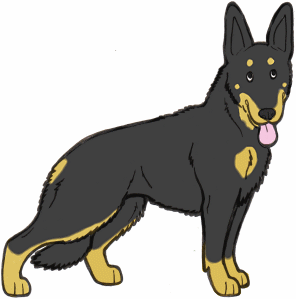
This means that all of the sable, agouti and tan-pointed dogs below that aren't brindled must be kyky on the K locus.
The eumelanin areas can be affected by liver (bb), dilution (dd), merle or greying.




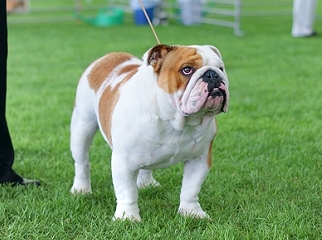
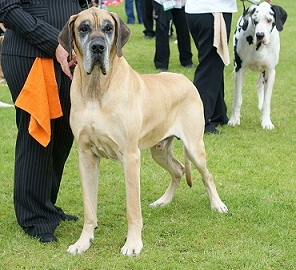
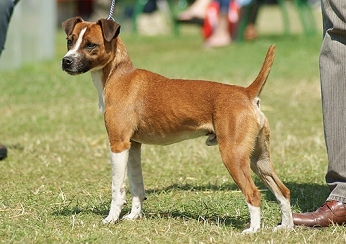

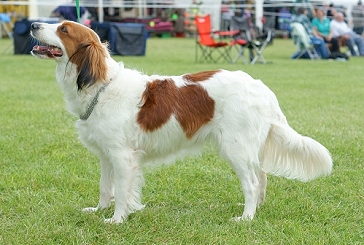
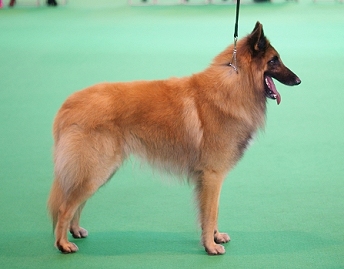
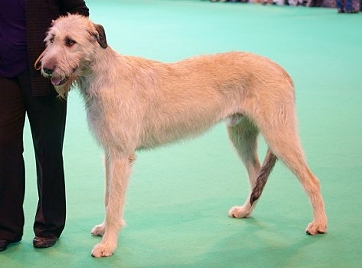
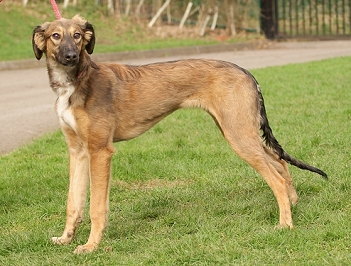

Shaded sables can appear very similar to agouti (aw) dogs. However, agouti does not display a widow's peak and will usually have a "spectacled" appearance around the eyes (see below).
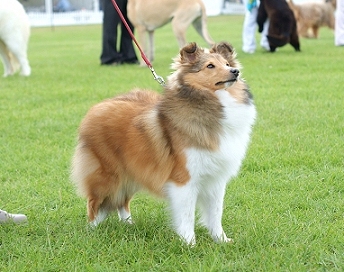
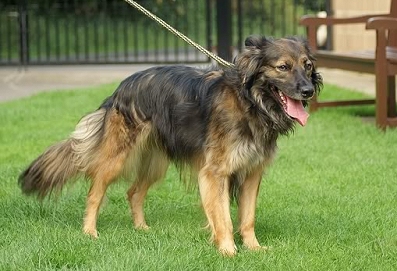

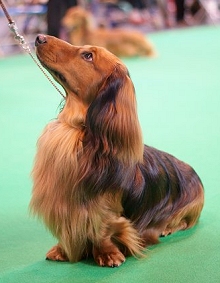

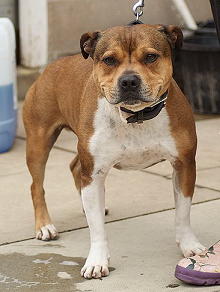
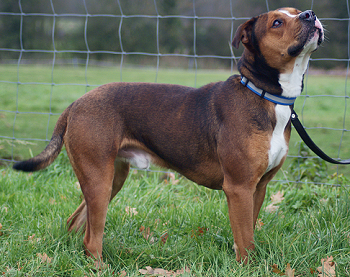
Shaded sable on shorthaired dogs.

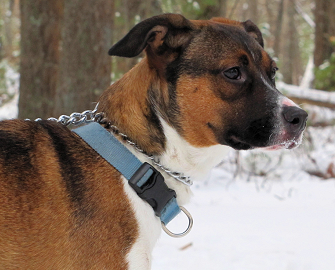
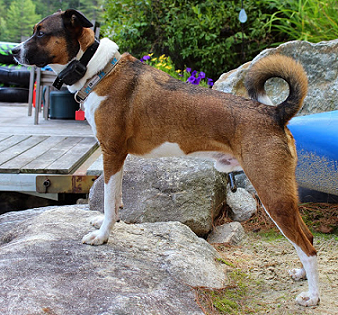
Cooper the mixed breed, owned by Abby L

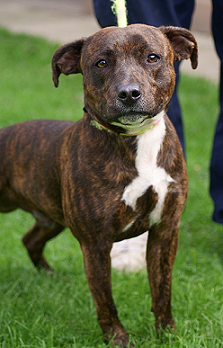
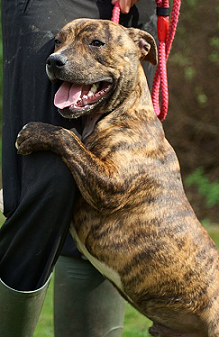
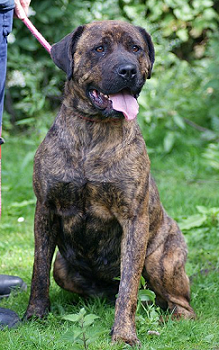

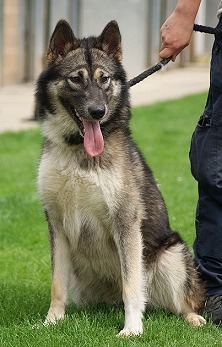
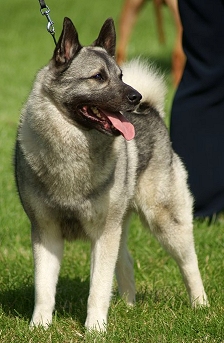
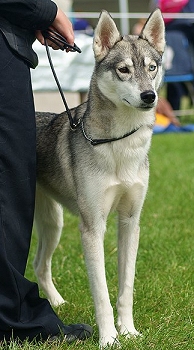
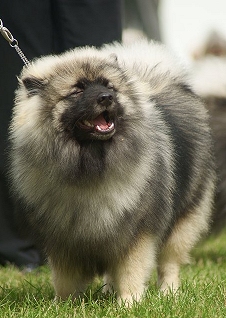

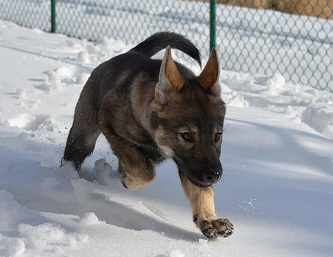
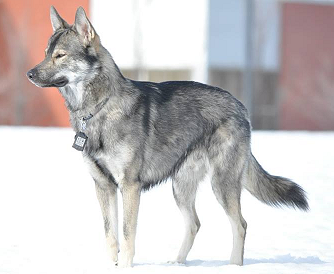
Wylie the Tamaskan Dog as a puppy and adult, submitted by Katlin Primrose

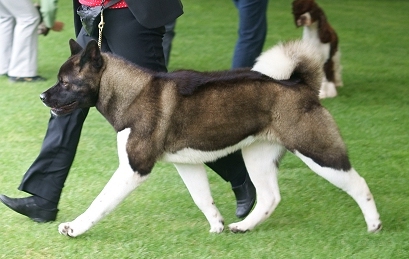
It is not clear whether this pattern in Akitas is due to the sable gene, seal or agouti. The tipped/banded hairs concentrated along the back are reminiscent of agouti, although Akitas appear to lack the typical pattern of light points associated with the agouti gene, and
also lack the "widow's peak" pattern of shaded sables. This is more likely to be seal, potentially even agouti seal.
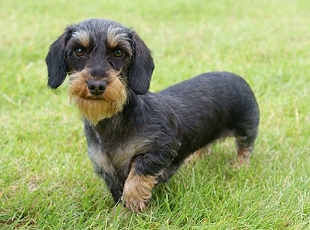
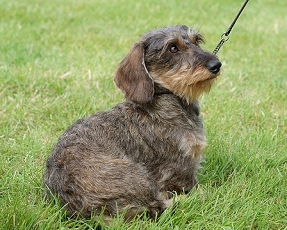
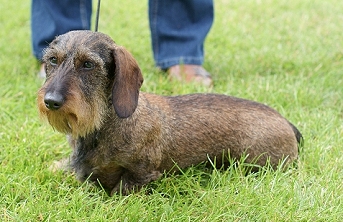
Agouti ("wild boar") in Dachshunds.
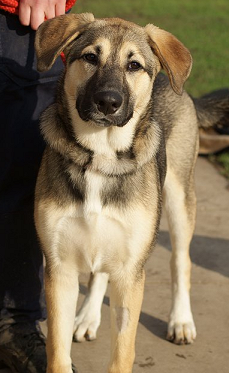
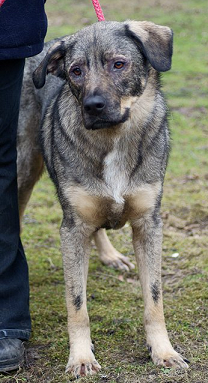
Here are two interesting mixed breeds that both appear to be agouti. They have very different patterns of phaeomelanin, with the points on the first dog extending much further on the face, legs and chest. The second dog is definitely agouti (the banding is clear, even from this photo!), but the first is more likely to be a shaded sable.
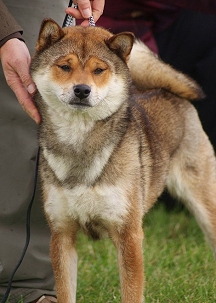
Finally, one more mystery. Is this Shiba Inu agouti or sable? This one is most likely to be a sable as there is a distinctive widow's peak with the shading not continuing under the eyes and down the top of the muzzle
as it does on the Husky in the section above.

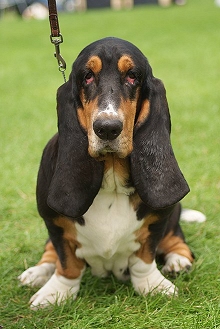
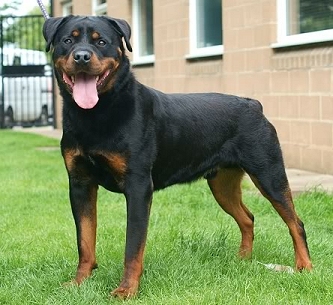
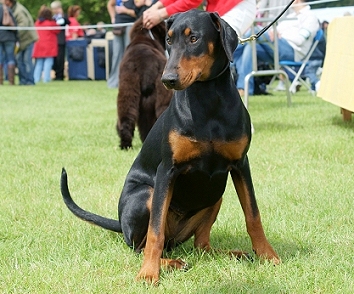
The Rottweiler and Dobermann are two of the most well-known breeds that carry only the tan-point allele on the A locus. All dogs of these breeds are tan-pointed.
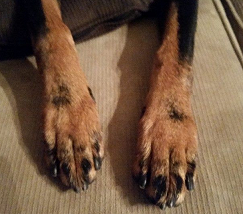
Pencilling on the toes of a Beauceron. Photo submitted by Victoria Paul.

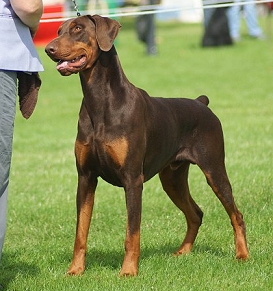
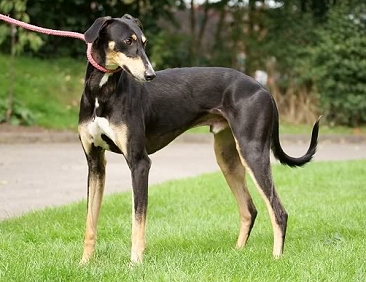
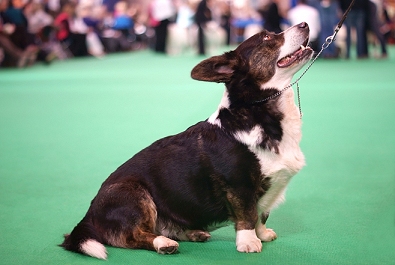

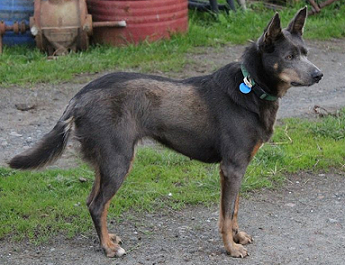
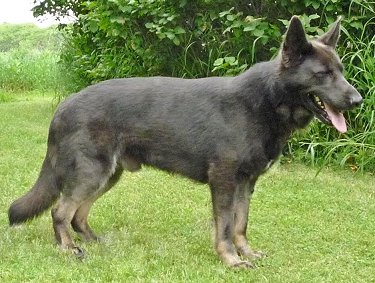
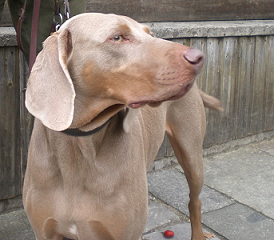
Kelpie photo submitted by Charlotte, German Shepherd Dog photo submitted by Laura Kelsch and Weimaraner submitted by Dr Anna Laukner

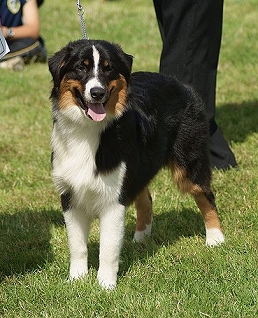
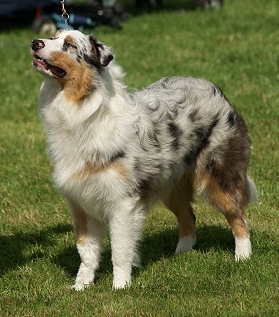
Note that "tricolour" refers ONLY to tan-pointed or saddle-marked dogs that also have white markings.

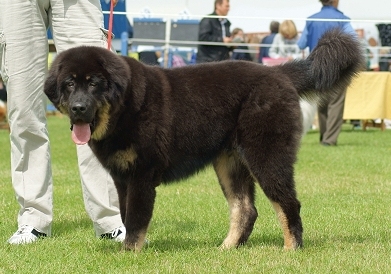
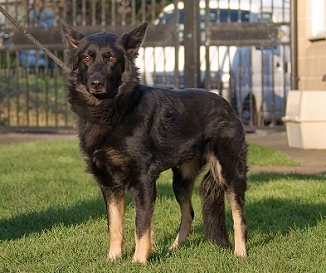
Sometimes the points on the face can be covered up by a mask, as on these two dogs. The eyebrow pips are still visible on the Tibetan Mastiff, but the sides
of the muzzle are covered by black. The German Shepherd crossbreed has a more extensive mask that also covers her eyebrow pips and partly obscures the points on the front of her chest.
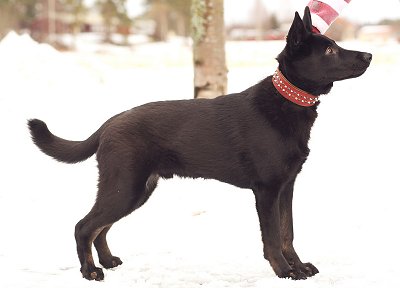
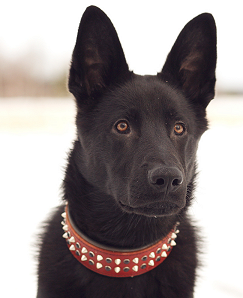
Astro here, submitted by Oona Pesonen, shows an extreme version of masking that covers almost all of his tan points. Dogs like Astro may appear almost entirely solid black, as in the second photo above. Astro is also likely to be a carrier of recessive black (a). For more examples of this type of masking, see the E series page.

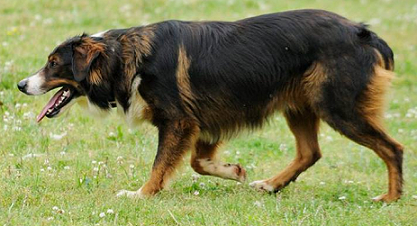
UKC Betts Best Buddy, submitted by Caroline Betts


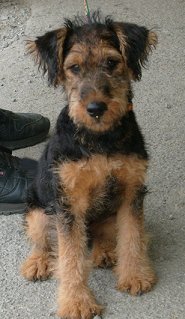
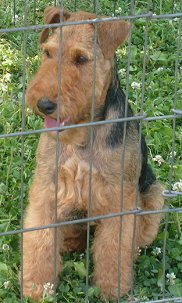
Compare this Airedale puppy with the adult on the right. The change is quite dramatic! Both of the photos were taken by Kenzie.

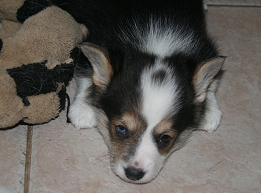
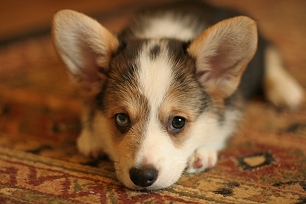
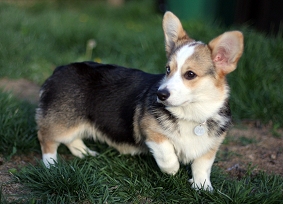
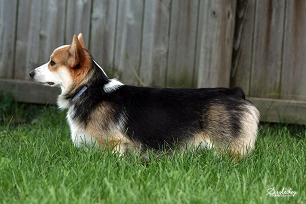
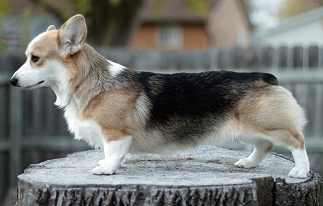
Photos of Revy submitted by Leah Petesch

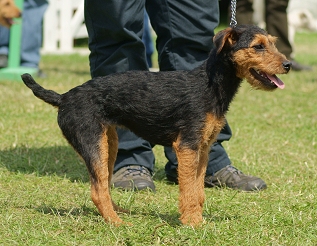
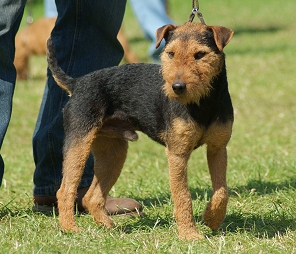
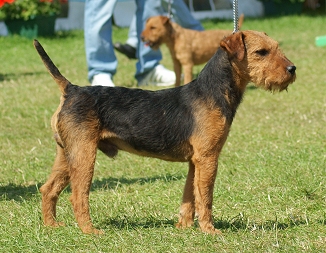
These three working Lakelands also show black "retreating". The dog on the left has the creeping tan pattern and the dog on the right has a large saddle. The dog inbetween would also be classed as creeping tan. Any one dog may go through all of these stages as it
grows - or may just stay like the dog on the left.

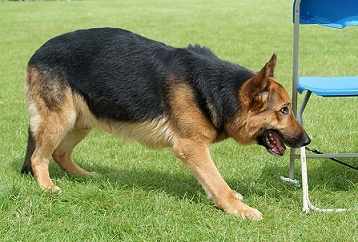
The saddle pattern is the main colour of the German Shepherd Dog, although often these dogs are just known as "black and tan" in the breed. This GSD also has
a black muzzle because of the mask allele (Em).
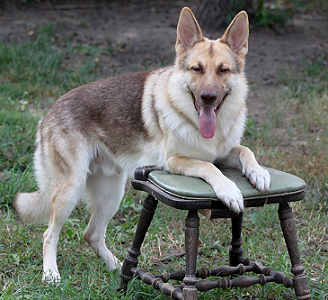
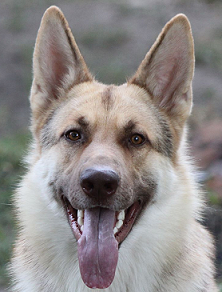
Darco is a saddle-patterned GSD with liver (bb) pigment, owned by Danae Lynn Federico. His saddle has receded further than the black-pigmented GSD above.

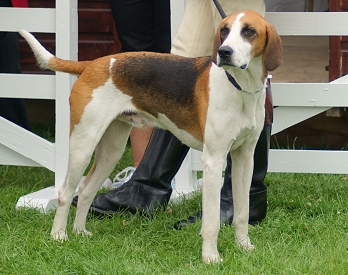
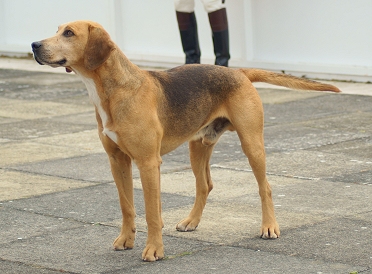
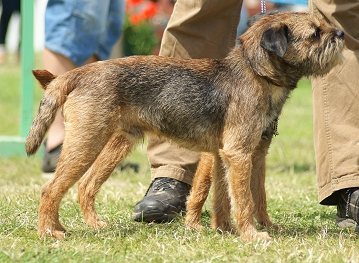
The German Pinscher below looks very similar to the dogs above, but is almost certainly a sable. We can be fairly sure of this because the German Pinscher does not generally come in any form of creeping or saddle tan. However, the two breeds shown above (English Foxhound and Border Terrier) do regularly come in saddle or creeping tan as well as sable, making it more difficult to distinguish between the colours.
To complicate matters further, domino/grizzle (Ed, Eg, and Eh) can also look extremely similar to creeping tan or saddle, and a form of grizzle is thought to potentially exist in some hounds, including foxhounds. Note that black masks can never appear on grizzle dogs, so this can be one distinguishing feature.
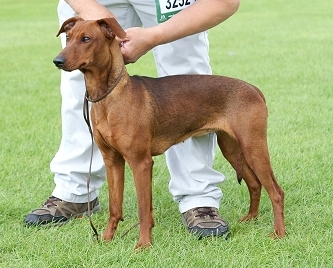






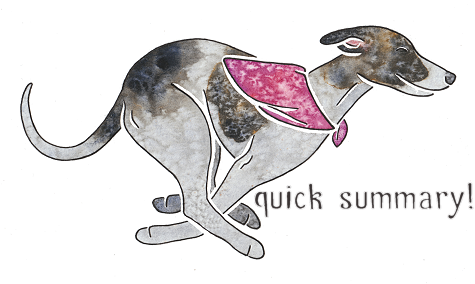
No time to read the whole thing? Here's the quick version!

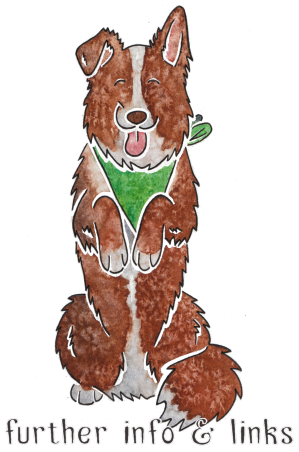
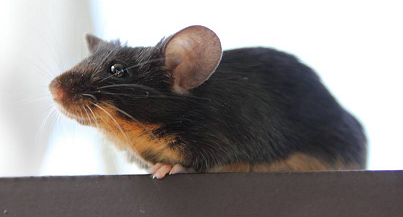
A black-and-tan mouse (photo provided by Heather Phillips). This pattern is caused by ASIP.
Genetic Interactions Among Three Pigmentation Loci in Domestic Dogs: https://asas.org/docs/default-source/wcgalp-proceedings-oral/278_paper_10239_manuscript_1637_0.pdf?sfvrsn=2
Identification of a mutation that is associated with the saddle tan and black-and-tan phenotypes in Basset Hounds and Pembroke Welsh Corgis: https://www.ncbi.nlm.nih.gov/pubmed/23519866

